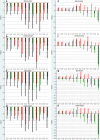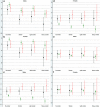The effect of smoking on the duration of life with and without disability, Belgium 1997-2011
- PMID: 25026981
- PMCID: PMC4223416
- DOI: 10.1186/1471-2458-14-723
The effect of smoking on the duration of life with and without disability, Belgium 1997-2011
Abstract
Background: Smoking is the single most important health threat yet there is no consistency as to whether non-smokers experience a compression of years lived with disability compared to (ex-)smokers. The objectives of the manuscript are (1) to assess the effect of smoking on the average years lived without disability (Disability Free Life Expectancy (DFLE)) and with disability (Disability Life Expectancy (DLE)) and (2) to estimate the extent to which these effects are due to better survival or reduced disability in never smokers.
Methods: Data on disability and mortality were provided by the Belgian Health Interview Survey 1997 and 2001 and a 10 years mortality follow-up of the survey participants. Disability was defined as difficulties in activities of daily living (ADL), in mobility, in continence or in sensory (vision, hearing) functions. Poisson and multinomial logistic regression models were fitted to estimate the probabilities of death and the prevalence of disability by age, gender and smoking status adjusted for socioeconomic position. The Sullivan method was used to estimate DFLE and DLE at age 30. The contribution of mortality and of disability to smoking related differences in DFLE and DLE was assessed using decomposition methods.
Results: Compared to never smokers, ex-smokers have a shorter life expectancy (LE) and DFLE but the number of years lived with disability is somewhat larger. For both sexes, the higher disability prevalence is the main contributing factor to the difference in DFLE and DLE. Smokers have a shorter LE, DFLE and DLE compared to never smokers. Both higher mortality and higher disability prevalence contribute to the difference in DFLE, but mortality is more important among males. Although both male and female smokers experience higher disability prevalence, their higher mortality outweighs their disability disadvantage resulting in a shorter DLE.
Conclusion: Smoking kills and shortens both life without and life with disability. Smoking related disability can however not be ignored, given its contribution to the excess years with disability especially in younger age groups.
Figures


Similar articles
-
Contribution of chronic conditions to smoking differences in life expectancy with and without disability in Belgium.Eur J Public Health. 2018 Oct 1;28(5):859-863. doi: 10.1093/eurpub/cky101. Eur J Public Health. 2018. PMID: 29901735
-
Total life expectancy and disability-free life expectancy and differences attributable to cigarettes' smoking among Chinese middle-aged and older adults.BMC Geriatr. 2024 Aug 8;24(1):663. doi: 10.1186/s12877-024-05007-z. BMC Geriatr. 2024. PMID: 39118038 Free PMC article.
-
Contribution of chronic conditions to gender disparities in health expectancies in Belgium, 2001, 2004 and 2008.Eur J Public Health. 2019 Feb 1;29(1):82-87. doi: 10.1093/eurpub/cky105. Eur J Public Health. 2019. PMID: 29917065
-
Regional patterns of disability-free life expectancy and disability-adjusted life expectancy: global Burden of Disease Study.Lancet. 1997 May 10;349(9062):1347-52. doi: 10.1016/S0140-6736(96)07494-6. Lancet. 1997. PMID: 9149696
-
Contribution of mortality and disability to the secular trend in health inequality at the turn of century in Belgium.Eur J Public Health. 2011 Dec;21(6):781-7. doi: 10.1093/eurpub/ckq198. Epub 2011 Jan 8. Eur J Public Health. 2011. PMID: 21217118
Cited by
-
Evolution of educational inequalities in site-specific cancer mortality among Belgian men between the 1990s and 2000s using a "fundamental cause" perspective.BMC Cancer. 2017 Jul 5;17(1):470. doi: 10.1186/s12885-017-3461-8. BMC Cancer. 2017. PMID: 28679369 Free PMC article.
-
Tobacco control for all ? The Belgian case.Tob Prev Cessat. 2017 May 11;3:16. doi: 10.18332/tpc/70872. eCollection 2017. Tob Prev Cessat. 2017. PMID: 32432190 Free PMC article.
-
Potential impact of reduced tobacco use on life and health expectancies in Belgium.Int J Public Health. 2020 Mar;65(2):129-138. doi: 10.1007/s00038-019-01315-z. Epub 2019 Nov 28. Int J Public Health. 2020. PMID: 31781804 Free PMC article.
-
Trajectories of Unhealthy Behaviors in Midlife and Risk of Disability at Older Ages in the Whitehall II Cohort Study.J Gerontol A Biol Sci Med Sci. 2016 Nov;71(11):1500-1506. doi: 10.1093/gerona/glw060. Epub 2016 Mar 30. J Gerontol A Biol Sci Med Sci. 2016. PMID: 27034508 Free PMC article.
-
Association between smoking status and handgrip strength in Korean male adults: based on Korea National Health and Nutrition Examination Survey 2016-2019.Front Med (Lausanne). 2023 Nov 27;10:1212946. doi: 10.3389/fmed.2023.1212946. eCollection 2023. Front Med (Lausanne). 2023. PMID: 38089872 Free PMC article.
References
-
- World Health Organisation. WHO Global Report: Mortality Attributable To Tobacco. Geneva: WHO; 2012. pp. 1–396.
-
- Jha P, Ramasundarahettige C, Landsman V, Rostron B, Thun M, Anderson RN, McAfee T, Peto R. 21st-century hazards of smoking and benefits of cessation in the United States. N Engl J Med. 2013;368:341–350. - PubMed
Publication types
MeSH terms
LinkOut - more resources
Full Text Sources
Other Literature Sources

